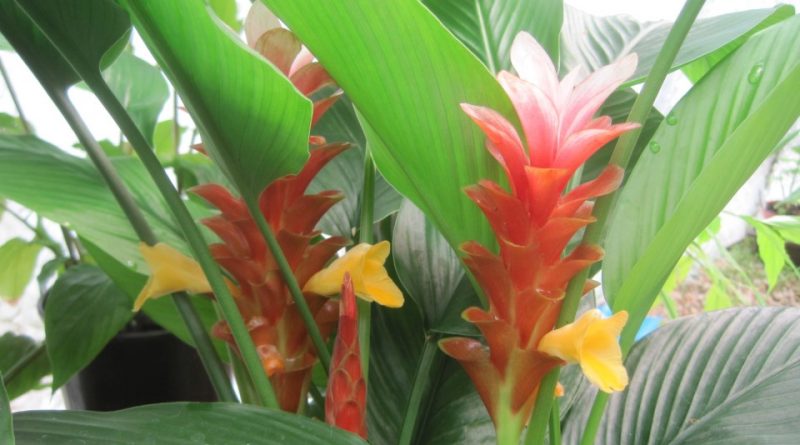Curcuma aurantiaca
Curcuma aurantiaca
Rainbow curcuma (Curcuma aurantiaca Zijp 1915) is a herbaceous species belonging to the Zingiberaceae family.
Systematic –
From a systematic point of view it belongs to:
Eukaryota domain,
Kingdom Plantae,
Division Magnoliophyta,
Class Liliopsida,
Subclass Zingiberidae,
Zingiberales Order,
Family Zingiberaceae,
Turmeric genus,
Species C. aurantiaca.
The term is synonymous:
– Curcuma ecalcarata Sivar. & Balach. (1983).
Etymology –
The term Turmeric comes from the Sanskrit kum kuma, through the Arabic kurkum, saffron, with reference to the saffron yellow color of the rhizome.
The specific epithet aurantiaca comes from the Latin “aurantiacus, a, um”, i.e. orange in colour, in reference to the color of the flowers.
Geographic Distribution and Habitat –
Curcuma aurantiaca is a plant native to Java, Peninsular Malaysia and Thailand.
Its habitat is that of the undergrowth of humid forests, in particular teak.
Description –
Curcuma aurantiaca is a herbaceous, perennial, rhizomatous, deciduous plant, with an erect habit that grows up to about 70 cm.
It has a small fleshy conical rhizome that is yellow internally.
The leaves are located on a 15-20 cm long petiole; they are basal, simple, elliptical with a pointed apex, 18-45 cm long and 8-25 cm wide, plicate, of a shiny intense green colour.
The inflorescences are borne by a 6-20 cm long peduncle; these are very variable in the shape and color of the bracts, they are terminal, cylindrical, 10-20 cm in length and 8-12 cm in diameter, made up of rounded bracts with curved apex of greenish yellow, pink, purple or brown colour, long 3 cm and 2.5 cm wide, which enclose the flowers with a three-lobed tubular corolla, 4.5-5.5 cm long, of an orange-yellow colour, an orange labellum about 2 cm long and staminodes of the same colour. The upper bracts without flowers, 4 cm long and 3.5 cm wide, are variable in colour, from greenish white to green, pink, brown or purple, and form a sort of tuft at the apex of the inflorescence.
The fruits are obovoid-shaped capsules about 1.5 cm in length and 1 cm in diameter.
Inside there are obovoid seeds equipped with a white aril.
Cultivation –
Curcuma aurantiaca is a perennial plant that is harvested in the wild for local use as food and medicine.
It is a humid tropical plant that prefers to grow in areas with a distinct dry season.
This plant generally prefers humus-rich, moist but well-drained soil in partial shade.
It is one of the most ornamental plants of the genus, due to its foliage and colorful inflorescences.
In the areas of origin it can withstand temperatures around 0 °C at rhizome level only if kept completely dry.
Outside the tropical and subtropical areas, the rhizomes can be buried in spring, at a depth of 5-10 cm, with flowering in late summer, and preserved in autumn, during the rest period, in a dry place at a temperature preferably higher than 10°C. During the vegetative period, watering must be regular and abundant, but without stagnation, and fertilization carried out with products balanced with microelements.
The plant reproduces by seed, in a substrate rich in humus with the addition of 30% sand or perlite, kept humid and in a shaded position, at a temperature of 22-26 °C, but usually and easily by division during the rest period .
It can also be reproduced by dividing the rhizome when the plant is dormant.
Customs and Traditions –
Curcuma aurantiaca is known by some common names including: rainbow curcuma (English); temu blobo, temu centot (Javanese); koneng kalamasu (Sundanese).
This plant is also collected and used in its natural or cultivated state.
The young inflorescences are consumed locally as a vegetable.
Furthermore, due to their long duration, of approximately 2 weeks or more, and their brilliant colours, cut inflorescences are highly appreciated in floral compositions.
The rhizomes are also used in the medicinal field.
Preparation Method –
Curcuma aurantiaca is a plant that is used both in the food and medicinal but also ornamental fields.
The young inflorescences are eaten as vegetables in ‘sayur’ (soup).
The rhizomes have a camphor scent. They are used medicinally for their astringent properties.
Guido Bissanti
Sources
– Acta Plantarum – Flora of the Italian Regions.
– Wikipedia, the free encyclopedia.
– GBIF, the Global Biodiversity Information Facility.
– Useful Tropical Plants Database.
– Conti F., Abbate G., Alessandrini A., Blasi C. (ed.), 2005. An annotated checklist of the Italian vascular flora, Palombi Editore.
– Pignatti S., 1982. Flora d’Italia, Edagricole, Bologna.
– Treben M., 2000. Health from the Lord’s Pharmacy, Advice and experiences with medicinal herbs, Ennsthaler Editore.
Photo source:
– https://repo.rbge.org.uk/image_server.php?kind=1500&path_base64=L2l0ZW1faW1hZ2VzL2FjY2Vzc2lvbnMvMjAvMDYvMDUvNjUvUGhvdG9fNGZkYjFkMGIxMmU4MS5qcGc=
– https://www.aubot.dk/specimenimages/Zingiberaceae_11_20042017/IMG_0151.jpg
Attention: Pharmaceutical applications and food uses are indicated for informational purposes only, they do not represent in any way a medical prescription; we therefore decline any responsibility for their use for healing, aesthetic or food purposes.


